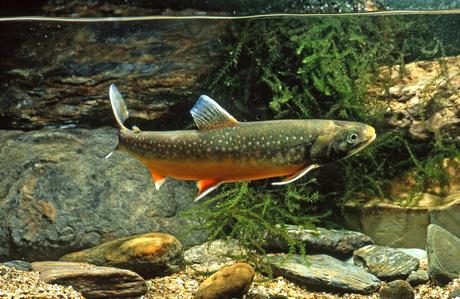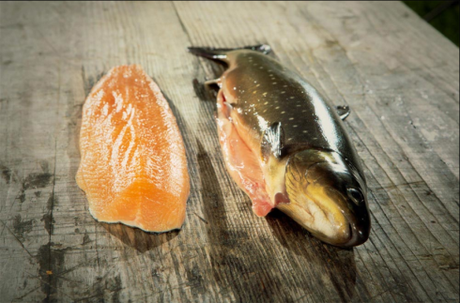
Schönen Valentinstag euch Allen!!! Ich bin wohl eine der wenigen Bloggerinnen die heute kein rosarotes, herzförmiges Dessert verbloggt  Vor kurzem wurde ich gefragt, ob ich einen Alpenlachs testen mag. Hm, komischer Fisch, hab ich noch nie gehört, dachte ich – es handelt sich dabei um eine Art Seesaibling, österreichs wertvollstem Fisch. Ich hab mich ein bisschen schlau gemacht und daraus gleich das heutige Foodie Focus gemacht. Also, Focus auf den Seesaibling!!
Vor kurzem wurde ich gefragt, ob ich einen Alpenlachs testen mag. Hm, komischer Fisch, hab ich noch nie gehört, dachte ich – es handelt sich dabei um eine Art Seesaibling, österreichs wertvollstem Fisch. Ich hab mich ein bisschen schlau gemacht und daraus gleich das heutige Foodie Focus gemacht. Also, Focus auf den Seesaibling!!
Happy Valentines day everyone!! I think I might be the only blogger who doesn’t post a heart-shaped, pink dessert today  Some time ago I was asked to try Alpine Salmon. Hm, strange fish, never heard before – but then I found out its a kind of arctic char, austrias most valuable fish. So I did some more research and decided to make it a Foodie Focus for you!
Some time ago I was asked to try Alpine Salmon. Hm, strange fish, never heard before – but then I found out its a kind of arctic char, austrias most valuable fish. So I did some more research and decided to make it a Foodie Focus for you!

(Quelle)
Herkunft / Origin
Der Seesaibling stammt aus der Region um Spitzbergen, und ist jene Art der Lachsfische, die sich am weitesten in den kalten Norden vorwagt. Er hat ein durch die Eiszeiten geprägtes, weitverstreutes Verbreitungsgebiet. Er lebt sowohl in isolierten Binnenseen, als auch in küstennahen Meeresgewässern im nördlichen Eismeer. Die Hauptfanggebiete für Seesaiblinge liegen in Großbritannien, Skandinavien, Island, Russland, Nordamerikas, Japans und den Alpenregionen. Der Alpenlachs ist ein Seesaibling der in den österreichischen Alpen auf ganz spezielle Art gehalten wird (mit Rundbecken mit Grundablass, in denen die Strömungsgeschwindigkeit durch die Drehung des Wassers geregelt werden – er schwimmt also nicht ständig gegen den Strom, was die Gesundheit der Fische fördert)
The arctic char is native to the region around Svalbard, and is the kind of salmon fish that venture into the cold north most. It has widely scattered distribution area, because of the ice ages. He lives both in isolated lakes and in coastal waters in the Arctic Ocean. The main fishing areas for arctic char are in the UK, Scandinavia, Iceland, Russia, North America, Japan and the Alpine regions. The Alpine Salmon is a char which is held in the Austrian Alps in a very special way (with round basins with drain, in which the flow rate can be controlled by the rotation of the water – so he does not swim constantly against the flow, which promotes the health of the fish)
Inhaltsstoffe und gesundheitlicher Wert / Ingredients and nutritional value
Der zu den Lachsfischen zählende Saibling hat ein ähnlich rosafarbenes Fleisch wie Lachs und ähnelt äußerlich und in der Größe der Forelle. Kaltwasserfische und besonders der Seesaibling enthalten einen besonders hohen Anteil an Omega-3-Fettsäuren. Omega-3-Fettsäuren sind ungesättigte Fettsäuren, die vor allem das Herz schützen, jedoch vom Körper nicht selbst hergestellt werden können. Daher ist es wichtig, sie über die Nahrung aufzunehmen. Der Saibling enthält zwar ein kleines bisschen mehr Fett als die ganz mageren Seefischarten, aber dennoch deutlich weniger als seine nächsten Verwandten Forelle und Lachs. Darüber hinaus liefert Saibling nennenswerte Mengen an Mineralstoffen wie Phosphor und Eisen, B-Vitaminen und Vitamin A.
The flesh of the arctic char is of a similar pink as salmon and the whole fish looks very similar to a trout. Cold-water fish, and especially the arctic char contain an especially high amount of omega-3 fatty acids. Omega-3 fatty acids are unsaturated fatty acids that protect the heart, but can not be manufactured by the body itself. Therefore, it is important to include them in the diet. Although the char contains a little more fat than some very lean fish species, but still significantly less than its nearest relatives trout and salmon. In addition, char yields appreciable amounts of minerals such as phosphorus and iron, B vitamins and vitamin A.
Verwendung / Usage
Saibling kann man am besten wie Forelle zubereiten: Er schmeckt pochiert, gebraten oder gegrillt. Auch gedünsteter Saibling ist lecker, und wer mag, kann Saibling außerdem wie Graved Lachs beizen. Selbst in einen Gemüseeintopf passen Filets vom Saibling perfekt. In nächster Zeit werd ich euch außerdem noch 2 leckere Rezepte mit dem gesunden Fisch vorstellen.
Char can best prepare like trout: It tastes poached, fried or grilled. Also steamed char is delicious, and if you like, you can also make it pickled. It even fits perfectly in a veggie stew. In the near future I will post two delicious recipes with this healthy fish.

(Quelle)
Wo kaufen? / Where to buy?
Am besten beim Fischhändler eurer Wahl. Achtet beim Einkauf auf absolute Frische: Ein natürliches Schimmern der Haut ohne Verfärbungen, klare und helle Augen sowie leuchtend rote Kiemen sind das verlässlichste Signal dafür, dass der Saibling frisch ist.
Best at your fishmonger of choice. Pay attention on absolute freshness: A natural shimmer of the skin without discoloration, clear and bright eyes and bright red gills are the most reliable signal that the char is fresh.
Ich hab den Alpenlachs im Endeffekt getestet, ich bekam zwei ganze, frische Fische und noch zwei Stück kalt geräucherten Fisch (den ich aufgrund der Schwangerschaft leider nicht essen kann  ) Mit den frischen Fischen hab ich zwei Rezepte getestet, beide sehr lecker, beide in Kürze hier am Blog!! Ich wünsch euch ein schönes Wochenende!!
) Mit den frischen Fischen hab ich zwei Rezepte getestet, beide sehr lecker, beide in Kürze hier am Blog!! Ich wünsch euch ein schönes Wochenende!!
I got the Alpine salmon to try in the end – I got two whole, fresh fish and two piece of cold-smoked fish (which I, unfortunately, can not eat because of the baby  ) With the fresh fish I’ve tested two recipes, both delicious, both here on the blog soon! I wish you a nice weekend!
) With the fresh fish I’ve tested two recipes, both delicious, both here on the blog soon! I wish you a nice weekend!

Link des Tages / Link of the day

Herziges Spiegelei / Hearty egg sunny side up


